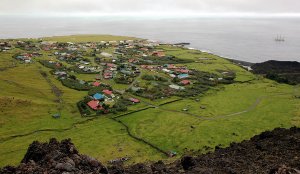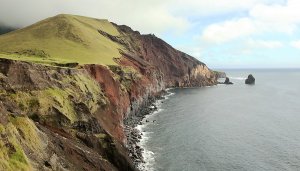Arto's Blog
The small quiet island called Tristan
Posted: 2015-10-25 22:53:00, Categories: Travel, Sailing, Tristan da Cunha, 1045 words (permalink)On Easter Monday the 6th of April we visited Tristan da Cunha, a small volcanic island in the middle of Atlantic Ocean. It was our only stop on the way from South Georgia towards Cape Town, a welcome opportunity to have a short break from sailing and to walk on land again. After a friendly welcome at the port and the tourist info, the Tristanians offered a selection of guided tours to see the island in an organized way, but many also took the chance to wander around on their own for at least part of the day.
The first thing we noticed when walking across the settlement was quietness. We didn't hear the ocean any more, nobody was driving a vehicle or working in the garden, even most the dogs just looked at us and didn't bark. A few locals walked down the street and greeted us with a soft "Good morning", shortly breaking the silence when passing by. We looked at the houses on both sides of the street, painted in different colours and surrounded by small gardens, and thought about how it would be to live in one of them. The door to the village church was open, we entered and were greeted by the reverend who soon held a short morning prayer. Only some of us visitors were present, the Easter service to the local population had most likely taken place already earlier.
Tristan advertises itself as the remotest (inhabited) island in the world, which makes it an exotic tourist attraction. With no airport and only a handful of ships per year, it is still far from being overrun by visitors. For most of the time, the 300 inhabitants live there largely on their own, with only a small number of "outsiders" such as a veterinarian and a couple of scientists added to the mix. It is a community where land belongs to everybody and where rules are designed to prevent large differences in wealth between the inhabitants. Every family is entitled to have a potato patch, two cows, two sheep and a few chicken, and they generally work as farmers or fishermen. Except for the possibility to buy daily commodities in the supermarket or to have a drink at the pub, money plays little role in their daily life. Besides the income from tourism, Tristan exports lobsters and sells fishing licenses which bring in enough money to fit the houses with a reasonable level of modern comforts. The income is also used to import tractors, tools and other items which are needed, or desired, and cannot be produced locally.
The whole island consists of one big volcano with some flatter areas around it. In 1961 a side crater erupted right next to the main settlement and the whole population of Tristan da Cunha were evacuated. Unimpressed by the life in England, almost all returned two years later and resumed their simple life on the island. Nowadays, there is a trail leading to the crater, where we headed after crossing the settlement. It was an easy half an hour hike across the lava field, with already small patches of grass and other plants pushing out between the volcanic rocks. At the top, we had a nice view over the settlement, called Edinburgh of the Seven Seas, and the grass fields surrounding it. The main volcano reaches a height of 2063 meters, but of that we only saw the first few hundred meters, the rest being hidden in clouds.
After coming down from the volcano we took a peek in the supermarket, which was larger and better stocked than we had expected. Obviously it wasn't comparable to supermarkets in big cities, but there were certainly more things available than in supermarkets in small Chilean and Argentinian towns earlier during our trip, or at the village shop next to our house back home in Germany. Most of the supply was shipped from Cape Town, but there were also home made cake and fresh tomatoes grown on the island, both of which found place in our shopping basket.
We joined a short tour presenting the village museum, a traditional house showing how life had been on the island about 100 years ago. After the tour we wrote a few postcards and had sandwiches for lunch, complemented with fresh tomatoes and apples from the shop. Then we started walking on the only road leading out from the settlement, which ends at the potato patches a few kilometres away. We didn't get far before being offered a ride at the back of a pick-up truck driven by Marc, a French scientist working at the nuclear test monitoring station located on the island. The station is part of the worldwide network of stations, which control that the international treaty banning nuclear tests is respected.
The potato patches were, unsurprisingly, small patches of land with fences around, protecting the plants from cows and donkeys which were freely roaming on the grasslands around. We started walking back enjoying the green peaceful landscape and the sun which started to appear from behind the clouds. Closer to the settlement we diverged a bit from the road and walked to the edge of the cliffs by the sea. Judging from the view, we could well have been at the sea coast in Cornwall in South Eastern England. Perhaps that inspired also the first English settlers who started inhabiting the island 200 years ago.
Upon returning at the settlement, we had still a quick tour by Marc at the monitoring station, then it was time to step in the zodiacs and return to the ship. We wished we had been able to stay at least a few days, to meet more locals and to appreciate the island in an appropriate way without hurry. Unfortunately our ship had a schedule to meet and in the evening the wind was blowing from a favourable direction for our passage towards Cape Town. After a short swim in the ocean and a dinner we lifted the anchor and sailed away.

Copyright Arto Teräs <ajt@iki.fi>, licensed under the Creative Commons Attribution-Share Alike 3.0 Unported License. (Unless otherwise mentioned in individual photos or other content.)






